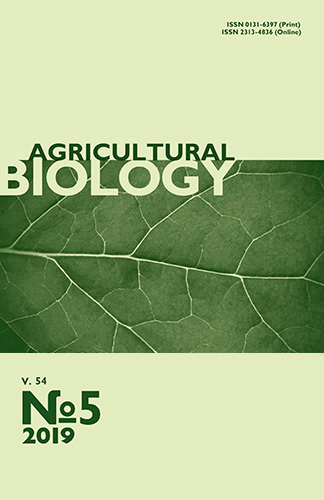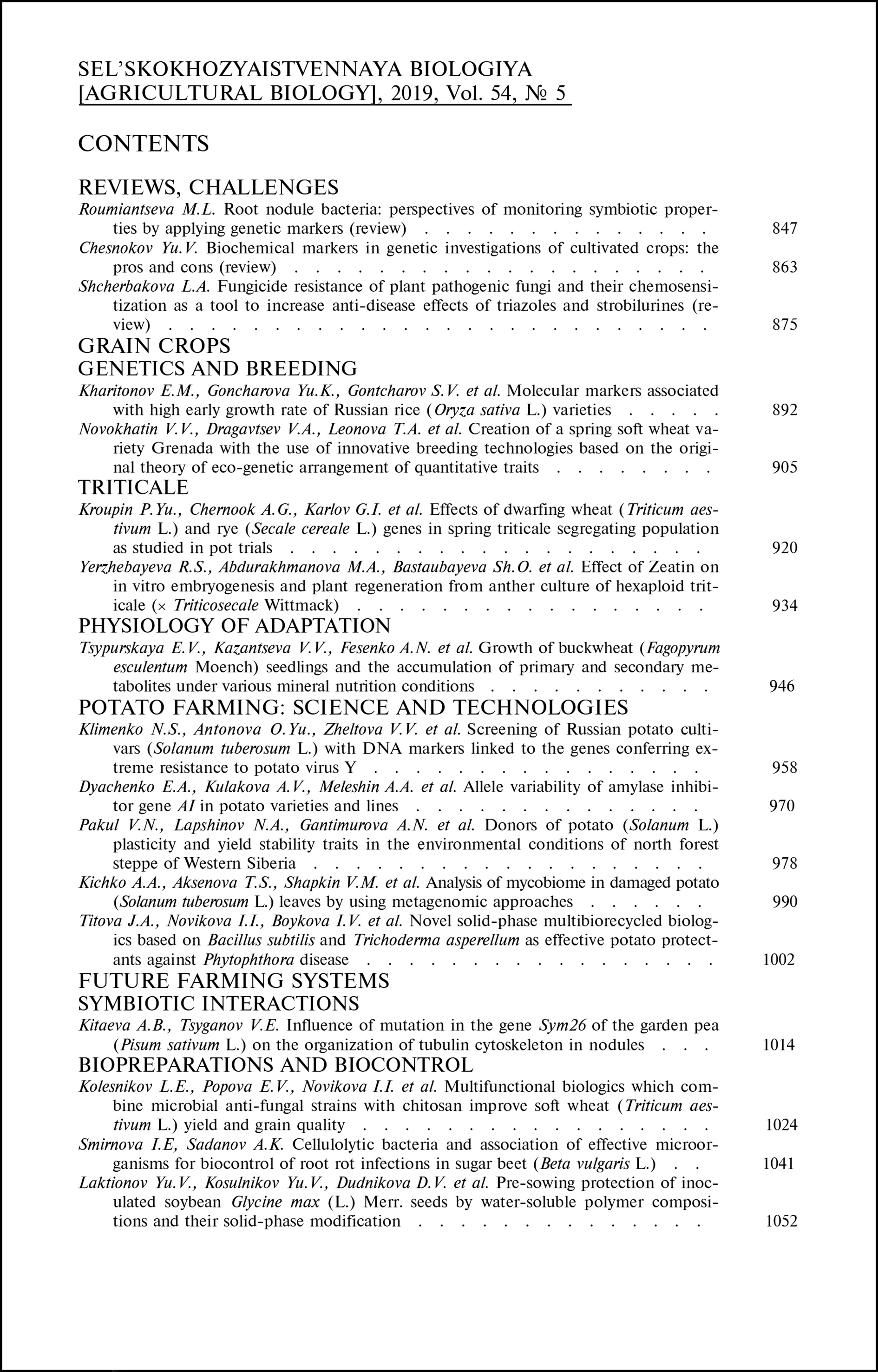doi: 10.15389/agrobiology.2019.5.863eng
UDC: 631.52:577.112:577.151.64:58.088
BIOCHEMICAL MARKERS IN GENETIC INVESTIGATIONS OF CULTIVATED CROPS: THE PROS AND CONS (review)
Yu.V. Chesnokov
Agrophysical Research Institute, 14, Grazhdanskii prosp., St. Petersburg, 195220 Russia, e-mail yuv_chesnokov@agrophys.ru (✉ corresponding author)
ORCID:
Chesnokov Yu.V. orcid.org/0000-0002-1134-0292
Received January 9, 2019
This literature review summarizes the accumulated knowledge and the author’s own research data about suitability of seed storage proteins, allozymes and isozymes as biochemical genetic markers. These markers have a huge potential, since it allows researchers to distinguish genotypes from other in a short time. Therewith, biochemical markers are usually tissue- and organ-specific. The advantages that these markers possess over morphological markers are shown. So biochemical markers can be used on a much larger number of experimental objects than morphological ones. Protein markers are usually characterized by a greater correspondence between genotype and phenotype, and, besides, the path to the implementation of genetic differences into phenotypic ones for protein markers is much shorter than for morphological ones. In addition, metabolites (sugars, carbohydrates, secondary metabolites, etc.), which are identified biochemically after isolation from the organs or tissues of the studied organism and purification, are also referred to biochemical genetic markers. Though more than half a century has passed since the first description of biochemical markers, the physicochemical bases to their detection and identification have hardly changed methodologically. This gives some limitations on their use in genetic investigations. For example, it is shown, that plant protein polymorphisms revealed by one-dimensional electrophoresis can be subjected to quality and quantity changes because of ecological stresses such as nutrition deficiency or temperature deviations. Researchers also must take into account casual destructive changes and breaks of the analyzed molecules for various reasons, including due to non-standard conditions for protein and polypeptide extraction and purification, as well as during electrophoretic separation, which leads to non-specific electrophoretic spectra. Because of degeneracy of the genetic code and the fact that not every amino acid substitution leads to a change in charge and the molecular weight of the protein, only 30 % of nucleotide substitutions can cause electrophoretically detected protein polymorphism. Only strict observance of all methodological, biological and other restrictions, as well as established requirements, allow the correct and skillful use of biochemical markers in genetic research.
Keywords: seed storage proteins, allozymes, isozymes, polymorphism, electrophoretic patterns, biochemical markers.
REFERENCES
- Solov'eva A.E., Artem'eva A.M. Trudy po prikladnoi botanike, genetike i selektsii, 1999, 157: 142-148 (in Russ.).
- Solov'eva A.E., Artem'eva A.M. Kapustnye rasteniya roda Brassica L. (Kharakteristika obraztsov po osnovnym biokhimicheskim pokazatelyam kachestva). Katalog mirovoi kollektsii VIR. Vyp. 756 [Brassica L. plants (characterization of the main biochemical quality indicators). VIR World Collection Catalog. Iss. 756]. St. Petersburg, 2004 (in Russ.).
- Solov'eva A.E., Artem'eva A.M. Agrarnaya Rossiya, 2006, 6: 52-56 (in Russ.).
- Solov'eva A.E., Artem'eva A.M. Agrarnaya Rossiya, 2010, 3: 17-20 (in Russ.).
- Bocharnikova N.I. Geneticheskaya kollektsiya mutantnykh form tomata i ee ispol'zovanie v selektsionno-geneticheskikh issledovaniyakh [Genetic collection of tomato mutants and its use in breeding and genetic studies]. Moscow, 2011 (in Russ.).
- Zhuchenko A.A., Korol' A.B. Rekombinatsiya v evolyutsii i selektsii [Recombination in evolution and breeding]. Moscow, 1985 (in Russ.).
- Zhuchenko A.A., Kibenko T.Ya., Khariton A.M. Tezisy dokladov konferentsii «Adaptatsiya i rekombinogenez u kul'turnykh rastenii» [Proc. Conf. «Adaptation and recombinogenesis in cultivated plants»]. Kishinev, 1982: 113 (in Russ.).
- McDonald J.F., Ayala F.J. Gene regulation in adaptive evolution. Canadian Journal of Genetics and Cytology, 1978, 20(2): 159-175.
- Ayala F.J., McDonald J.F. Continuous variation: possible role of regulatory genes. Genetica, 1980, 52/53: 1-15 CrossRef
- Zhuchenko A.A., Kibenko T.Ya., Khariton A.M., Korol' A.B. Fiziologiya i biokhimiya kul'turnykh rastenii, 1984, 16(4): 376-380 (in Russ.).
- Konarev A.V. Agrarnaya Rossiya, 2002, 3: 4-11 (in Russ.).
- Garvin D.F., Brown A.H.D., Raman H., Read B.J. Genetic mapping of the barley Rrs 14 scald resistance gene with RFLP, isozyme and seed storage protein markers. Plant Breeding, 2000, 119: 193-196 CrossRef
- Bahrman N., Damerval C. Linkage relationships of loci controlling protein amount in maritime pine (Pinus pinaster Ait.). Heredity, 1989, 63: 267-274 CrossRef
- Gerber S., Rodolphe F., Bahrman N., Baradat P.H. Seed-protein variation in maritime pine (Pinus pinaster Ait.) revealed by two-dimensional electrophoresis: genetic determination and construction of a linkage map. Theoretical and Applied Genetics, 1993, 85: 521-528 CrossRef
- Plomion C., Bahrman D., Durel C.E., O’Malley D.M. Genomic mapping in Pinus pinaster (maritime pine) using RAPD and protein markers. Heredity, 1995, 74: 661-668 CrossRef
- Plomion C., O’Malley D.M., Durel C.E. Genomic analysis in maritime pine (Pinus pinaster). Comparison of two rapid maps using selfed and open-pollinated seeds of the same individual. Theoretical and Applied Genetics, 1995, 90: 1028-1034 CrossRef
- Plotnikov V.K. Biologiya RNK zernovykh kul'tur [Biology of cereal RNA]. Krasnodar, 2009 (in Russ.).
- Chesnokov Yu.V. Molekulyarnye markery i ikh ispol'zovanie v prebridingovykh issledovaniyakh [Molecular markers and their use in prebreeding]. St. Petersburg, 2013 (in Russ.).
- May B. Starch gel electrophoresis of allozymes. In: Molecular genetic analysis of populations: a practical approach. A.R. Hoelzel (ed.). IRL Press, Oxford, 1992: 1-27.
- Lewontin R.C., Hubby J.L. A molecular approach to study of genetic heterozygosity in natural populations. II. Amount of variation and degree of heterozygosity in natural populations of Drosophila pseudoobscura. Genetics, 1966, 54: 595-609.
- Murphy R.W., Sites J.W. Jr., Buth D.G., Haufler C.H. Proteins I: isozyme electrophoresis. In: Molecular systematics. D.M. Hillis, C. Moritz (eds.). Sinauer Associates, Sunderland, MA, 1990: 45-126.
- Tanksley S.D., Rick C.M. Isozymic gene linkage map of the tomato: application in genetics and breeding. Theoretical and Applied Genetics, 1980, 57: 161-170 CrossRef
- Bernatzky R., Tanksley S.D. Toward a saturated linkage map in tomato based on isozymes and random cDNA sequences. Genetics, 1986, 112: 887-898.
- Tanksley S.D. Molecular markers in plant breeding. Plant Molecular Biology Reporter, 1983, 1: 3-8 CrossRef
- Tanksley S.D., Jones R.A. Application of alcohol dehydrogenase allozymes in testing the purity of F1 hybrids of tomato. HortScience, 1979, 16(2): 179-181.
- Rick C.M., DeVerna J.W., Chetelat R.T., Stevens M.A. Meiosis in sesquidiploid hybrids of Lycopersicon esculentum and Solanum lycopersicoides. PNAS USA, 1986, 83: 3580-3583 CrossRef
- Zamir D., Tanksley S.D., Jones R.A. Haploid selection for low temperature tolerance of tomato pollen. Genetics, 1982, 101: 129-137.
- Zamir D., Tanksley S.D., Jones R.A. Genetic analysis of the origin of plants regeneration from anther tissues of Lycopesicon esculentum Mill. Plant Science Letters, 1981, 21: 223-227 CrossRef
- Pogson G.H., Mesa K.A., Boutilier R.G. Genetic population structure and gene flow in the Atlantic cod Cadus morhua: a comparison of allozyme and nuclear RFLP loci. Genetics, 1995, 139(1): 375-385.
- Charcosset A., Gallais A. Application of markers in selection. In: Molecular markers in plant genetics and biotechnology. D. De Vienne (ed.). Science Publishers, Inc. Enfield, NH, 2003: 153-176.
- Vallejos C.E. Enzyme activity staining. In: Isozymes in plant genetics and breeding. S.D. Tanksley, T.J. Orton (eds.). Elsevier, Amsterdam, 1983: 37-49.
- Shewry P., Franklin J., Parmar S., Smith S.J., Miflin B.J. The effects of sulphur starvation on amino acid and protein compositions of barley grain. Journal of Cereal Science, 1983, 1: 21-31 CrossRef
- Spencer D., Rerie W.G., Randall P.J., Higgins T.J.V. The regulation of pea seed storage protein genes by sulphur stress. Australian Journal of Plant Physiology, 1990, 17: 355-363 CrossRef
- Chiaese P., Ohkama-Ohtsu N., Molvig L., Godfree R., Dove H., Hocart C., Fujiwara T., Higgins T.J., Tabe L.M. Sulphur and nitrogen nutrition influence the response of chickpea seeds to an added, transgenic sink for organic sulphur. Journal of Experimental Botany, 2004, 55: 1889-1901 CrossRef
- Sharma A., Sharma S. Effect of nitrogen and sulphur nutrition on storage protein quality in soybean [Glycine max (L.) Merrill]. Journal of Applied and Natural Science, 2018, 10(1): 296-300 CrossRef
- Shewry P., Casey R. Seed proteins. In: Seed proteins. P. Shewry, R. Casey (eds.). Kluwer Acad. Publishers, Dordrecht, London, 1999: 1-10.
- Tabe L., Hagan N., Higgins T.J.V. Plastisity of seed protein composition in response to nitrogen and sulphur availability. Current Opinion in Plant Biology, 2002, 5: 212-217 CrossRef
- Crouch M., Sussex I.M. Development and storage-protein synthesis in Brassica napus L. embryos in vivo and in vitro. Planta, 1981, 153: 64-74 CrossRef
- Shwenke K.D., Raab B., Plietz P., Damaschun G. The structure of the 12S globulin from rapeseed (Brassica napus L.). Die Nahrung, 1983, 27: 165-175 CrossRef
- Mimouni B., Robin J.-M., Azanza J.-L. Comparative studies of 11S globulin constituents of Brassica napus L. and of its related species Brassica campestris L. and Brassica oleracea L. Plant Science, 1990, 67: 183-194 CrossRef
- Chesnokov Yu.V., Shutov A.D. 11S seed storage globulins: are they reliable as molecular markers? In: Recent Research Developments in Genetics and Breeding. Research Signpost, Kerala, India, 2004, Vol. 1: 181-194.
- International Rules for Seed Testing. Rules 1996. Verification of species and cultivars. Seed Science Technology, 1996, 24(Suppl.): 253-270.
- Teoreticheskie osnovy selektsii. Tom 1. Molekulyarno-biologicheskie aspekty prikladnoi botaniki, genetiki i selektsii /Pod redaktsiei V.G. Konareva [Theoretical foundations of breeding. Vol. 1. Molecular and biological aspects of applied botany, genetics and selection. V.G. Konarev (ed.)]. Moscow, 1993 (in Russ.).
- Eggi E.E., Vishnevskaya M.S., Ageeva P.A., Mekhtiev V.S., Gavrilyuk I.P., Gaponov N.V., Krasil'nikov V.N. Agrarnaya Rossiya, 2012, 4: 2-8 (in Russ.).
- Karp A., Kresovich S., Bhat K.V., Ayad W.G., Hodgkin T. Molecular tools in plant genetic resources conservation: a guide to the technologies. IPGRI Technical Bulletin, No. 2. International Plant Genetic Resources Institute, Rome, Italy, 1997.
- Spooner D., Van Treuren R., De Vicente M.C. Molecular marker for gene bank management. IPGRI Technical Bulletin, No. 10. International Plant Genetic Resources Institute, Rome, Italy, 2005.
- Shutov A., Rudakov S., Rudakova A., Seferova I., Kakhovskaya I., Alpat'eva N., Timofeeva G., CHesnokov YU. Leguminopodobnyi belok semyan soi: ochistka i nekotorye svoistva. Analele Stiintifice ale Universitatii de Stat din Moldova, Seria «Stiinte chimico-biologice». Chisinau, CEP USM, 2006: 240-243.
- Vertii S.A., Vetrukova A.M., Volkova V.A., Konarev V.G., Gavrilyuk I.P., Khakimova A.G. Doklady VASKHNIL, 1972, 4: 8-10 (in Russ.).
- Bukreeva I.G., Mel'nikova E.E., Plotnikov V.K. Materialy dokladov Mezhdunarodnoi konferentsii «Sovremennaya fiziologiya rastenii: ot molekul do ekosistem» [Proc. Int. Conf. «Modern plant physiology: from molecules to ecosystems»]. Syktyvkar, 2007, chast’ 3: 14-15 (in Russ.).
- Skoups R. Metody ochistki belkov [Methods of protein purification]. Moscow, 1985 (in Russ.).
- Autran J.C., Halford N.G., Shewry P.R. The biochemistry and molecular biology of seed storage proteins. In: Plant nitrogen. P.J. Lea, J.F. Morot-Gaudry (eds.). Springer, Berlin, Heidelberg, 2001: 295-341 CrossRef
- Antoshkina M.S., Dobrutskaya E.G., Gins V.K., Startsev V.I., Farber S.P. Metodicheskie rekomendatsii po analizu belkov semyan kapustnykh kul'tur metodom elektroforeza [Guidelines for the analysis of seed proteins of cabbage crops by electrophoresis]. Moscow, 2007 (in Russ.).
- Naimov S.N., Kasymova G.F., Dontsova S.V., Nigmonov M. Materialy dokladov Mezhdunarodnoi konferentsii «Sovremennaya fiziologiya rastenii: ot molekul do ekosistem» [Proc. Int. Conf. «Modern plant physiology: from molecules to ecosystems»]. Syktyvkar, 2007, chast’ 1: 202-203 (in Russ.).
- Larikova Yu.S. Materialy dokladov Mezhdunarodnoi konferentsii «Sovremennaya fiziologiya rastenii: ot molekul do ekosistem» [Proc. Int. Conf. «Modern plant physiology: from molecules to ecosystems»]. Syktyvkar, 2007, chast’ 3: 376-378 (in Russ.).
- Chesnokov Yu.V., Shutov A.D. Doklady RASKHN, 2006, 3: 7-11 (in Russ.).
- Chesnokov Yu.V. Geneticheskie resursy rastenii i sovremennye metody DNK-tipirovaniya [Plant genetic resources and modern DNA typing techniques]. St. Petersburg, 2007 (in Russ.).
- Stefanov V.E., Mavropulo-Stolyarenko G.R. Analiz struktury belkov metodami bioinformatiki [Bioinformatic analysis of proteins structure]. St. Petersburg, 2007 (in Russ.).
- Brown A.H.D., Marshall D.R., Munday J. Adaptedness of variants at an alcohol dehydrogenase locus in Bromus mollis L. (soft brome grass). Australian Journal of Biology. Science, 1976, 29: 389-396 CrossRef












